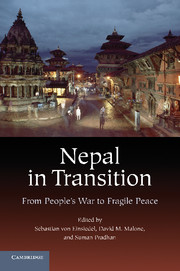Book contents
- Frontmatter
- Contents
- Contributors
- Acknowledgments
- 1 Introduction
- The Context
- 2 The Making of the Maoist Insurgency
- 3 State Power and the Security Sector: Ideologies and Interests
- 4 The Legacy of Nepal's Failed Development
- 5 Ethnic Politics and the Building of an Inclusive State
- Critical Transition and the Role of Outsiders
- Regional Dynamics
- Conclusions
- Index
- References
3 - State Power and the Security Sector: Ideologies and Interests
Published online by Cambridge University Press: 05 April 2012
- Frontmatter
- Contents
- Contributors
- Acknowledgments
- 1 Introduction
- The Context
- 2 The Making of the Maoist Insurgency
- 3 State Power and the Security Sector: Ideologies and Interests
- 4 The Legacy of Nepal's Failed Development
- 5 Ethnic Politics and the Building of an Inclusive State
- Critical Transition and the Role of Outsiders
- Regional Dynamics
- Conclusions
- Index
- References
Summary
Introduction
Nepal's peace process will not be complete until the future of the two major forces that fought the war is resolved. The November 2006 Comprehensive Peace Agreement (CPA) called for parallel processes of integrating and rehabilitating Maoist combatants and bringing the Nepalese Army (NA) under democratic control, as well as adjusting its size and making its composition more inclusive. These processes were not mapped out in detail, nor has there been significant progress on either. Members of the Maoist People's Liberation Army (PLA) have remained in cantonments since the end of 2006, and discussions over their future have made little headway. The NA dropped its “Royal” designation but has maintained its full conflict-era strength and, despite the introduction of a 2006 Army Act bringing it nominally under cabinet control, retains both day-to-day autonomy and a significant political role.
The measures that need to be taken to resolve this impasse do not neatly fit standard international models. The peace deal emerged from a military stalemate, in which neither force had been defeated. This has reduced incentives to accept compromise and understandably led the Maoists to reject forcefully the imposition of typical disarmament, demobilization, and rehabilitation models. The NA and its political backers have similarly rejected the need for systematic security sector reform, arguing that the transition away from palace control is complete and that the NA's exclusive legitimacy should not be tarnished by equating it with former rebel fighters. Therefore reforming the security sector presents much more than a technical challenge.
- Type
- Chapter
- Information
- Nepal in TransitionFrom People's War to Fragile Peace, pp. 58 - 80Publisher: Cambridge University PressPrint publication year: 2012
References
- 4
- Cited by



